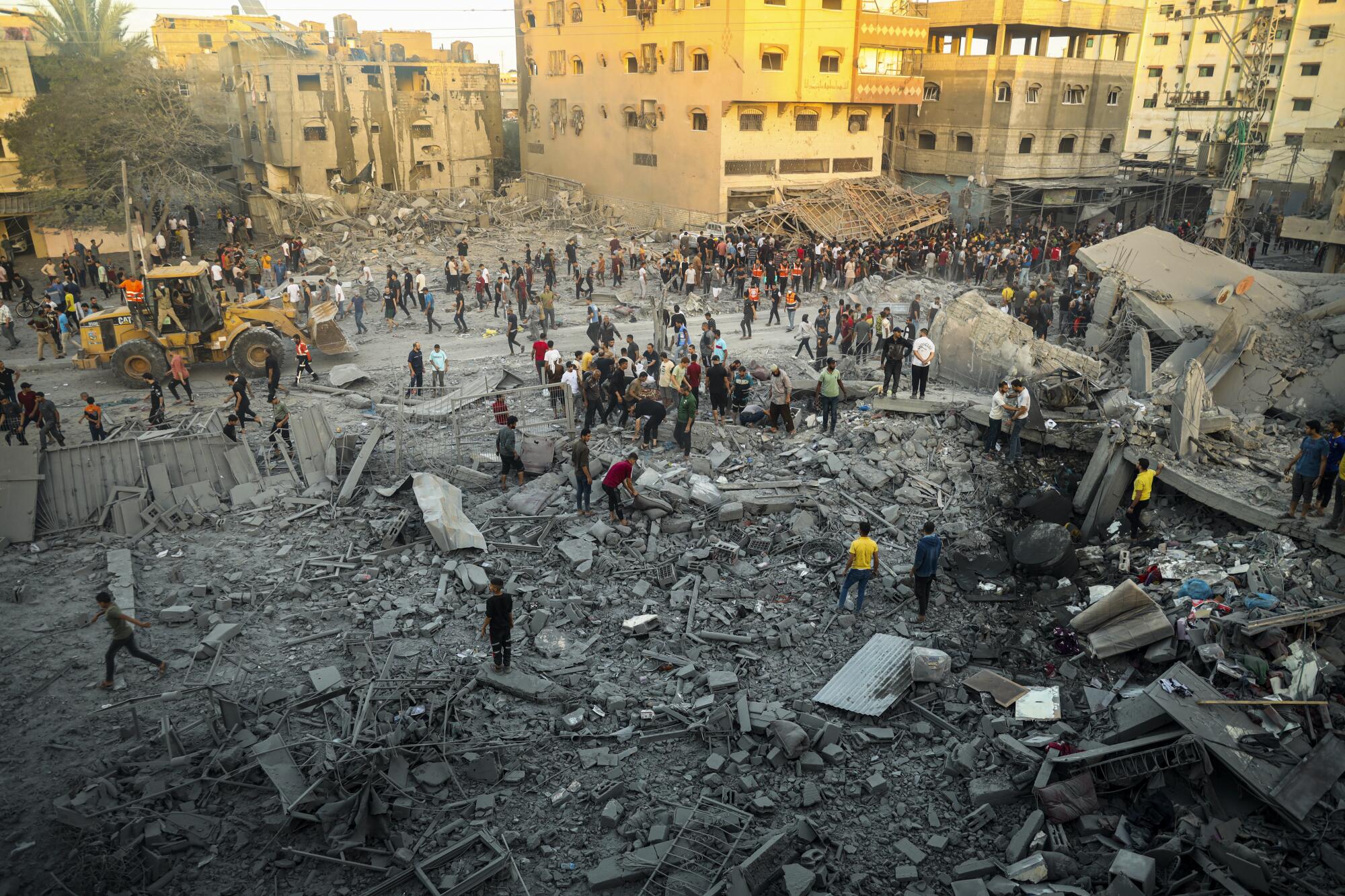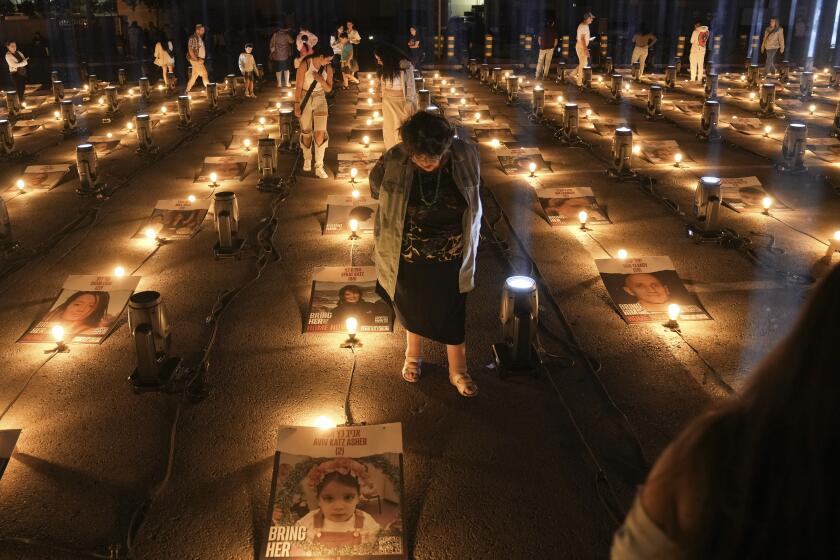
- Share via
KHAN YUNIS, Gaza Strip — Palestinians living in the heart of Gaza City said Wednesday they could see and hear Israeli ground forces closing in from multiple directions, accelerating the exodus of thousands of civilians as food and water become scarce and urban fighting between Israel and Hamas heats up.
The Israeli army has not given specifics on troop movements as it presses its ground assault, vowing to crush Hamas after its deadly Oct. 7 assault inside Israel. But residents said Israeli forces had moved into inner neighborhoods of Gaza City amid intense bombardment in the surrounding northern part of the Gaza Strip.
Clashes took place within a kilometer — 0.6 of a mile — of the territory’s largest hospital, Shifa, which has become a focal point in the war.
The Israeli military says that Hamas’ main command center is located in and under the hospital complex and that senior leaders of the group are hiding there, using the facility as a shield.
Hamas and hospital staff deny the claim and say the Israeli military is creating a pretext to strike it.
For Palestinians in Gaza, the hospital is a symbol of civilian suffering in the war. Like others, it has been overwhelmed by a constant stream of wounded, struggling to function as electricity and medical supplies run out. Tens of thousands of displaced people have been sheltering in and around the complex.
More than 70% of Gaza’s population of 2.3 million have left their homes, but the number of people making their way south has picked up pace recently as Israeli troops battle militants inside Gaza City and the humanitarian situation grows increasingly dire.
The Group of 7 wealthy industrialized nations announced a unified stance on the Israel-Hamas war after intensive meetings in Tokyo, condemning Hamas and supporting Israel’s right to self-defense. But the group also called Wednesday for the “unimpeded” delivery of food, water, medicine and fuel, and for “humanitarian pauses” in the fighting.
Israeli Prime Minister Benjamin Netanyahu has left open the possibility of small pauses to deliver humanitarian aid, but has ruled out a broader cease-fire unless all hostages seized last month are freed.
There remains no real end in sight to the war.

Israel has said that its war to end Hamas’ rule and crush its military capabilities will be long and difficult and that it will maintain some form of control over the coastal enclave indefinitely — though how it will achieve that remains unclear.
Support for the war remains strong in Israel, where the focus has been on the fate of the more than 240 hostages held by Hamas and other militant groups since Oct. 7.
The road out of the north
About 15,000 people fled northern Gaza on Tuesday — triple the number who left Monday — according to the United Nations Office for the Coordination of Humanitarian Affairs.
On Wednesday, thousands more made their way down Salah al Din Street, Gaza’s main north-south highway, during a daily window set by Israel, now extended to five hours.
A Times special correspondent in Gaza offers a personal account of living in a place where nowhere feels safe.
Families filled the road, almost all on foot, with men and women carrying young children or pushing the elderly on makeshift carts. Most had only a few belongings in backpacks. A few families rode on donkey carts, holding white flags as they approached Israeli tanks. The U.N. said some reported that people were arrested as they crossed Israeli checkpoints.
“We didn’t have food or drinking water. ... They struck the bakeries. There is no life in Gaza,” said Abeer Akila, who left her home in Gaza City with her family and neighbors after heavy bombardment overnight.
Residents reported loud explosions overnight into Wednesday across Gaza City and in its Shati refugee camp, which houses Palestinian families who fled from or were driven out of what is now Israel during the 1948 war surrounding its establishment.

The Israeli army’s chief spokesperson, Rear Adm. Daniel Hagari, said late Tuesday that ground forces had reached “the depths of Gaza City.” The Israeli military said Wednesday that it had killed one of Hamas’ leading developers of rockets and other weapons, without saying where he was killed.
A month after Hamas’ surprise attack nearly brought Israel to its knees, the country’s battered ‘peace camp’ is rising — or trying its best to do so.
Israel is focusing its operations on Gaza City, which was home to some 650,000 people before the war and where the military says Hamas has its central command and a vast labyrinth of tunnels.
Hundreds of thousands of Gazans have heeded Israeli orders to flee the north in recent weeks, even though Israel also routinely strikes what it says are militant targets in the south, often killing civilians.
Airstrikes flatten blocks of Gaza refugee camp, bringing rage, grief and a perilous new phase of war
Israel’s military says it killed a Hamas commander in devastating strikes in Jabaliya refugee camp in Gaza. Hospital chief describes ‘waterfall of casualties.’
Tens of thousands of Palestinians remain in the north, however, many sheltering at hospitals or U.N. schools. The trickle of aid entering Gaza from the south is largely barred from going to the north, which has been without running water for weeks. Hospitals running low on supplies are performing surgeries — including amputations — without anesthesia, according to the U.N. aid office. It said the last functioning bakeries shut down Tuesday for lack of fuel, water and flour, and some Gazans on the road south have talked about living on only one piece of pita bread a day.
Majed Haroun, who lives in Gaza City, said women and children who lost families go door to door begging for food.
“No words can describe what we are experiencing,” he said.

Conditions little better in the south
The new arrivals from the north are squeezing into homes with extended family or in U.N. schools turned into shelters where hundreds of thousands are taking refuge. At one, 600 people must share a single toilet, according to the U.N. office.
An Israeli airstrike hit a family house in the Nuseirat refugee camp in central Gaza on Wednesday, killing at least 18 people and wounding dozens of others, according to Iyad Abu Zaher, director of the nearby Al Aqsa Martyrs Hospital, where the dead and wounded were brought in. He said the toll could rise, as medics and first responders were still searching the rubble.
Hundreds of trucks carrying aid have been allowed to enter Gaza from Egypt since Oct. 21. But humanitarian workers say the aid is far short of mounting needs.
“There is an ocean of needs in Gaza right now, and what’s been getting in is a drop in the ocean. We need fuel, we need water, we need food and we need medical supplies,” said Dominic Allen of the United Nations Population Fund, speaking in the Israeli-occupied West Bank.
Violence surges in the West Bank as Israel increases raids to root out militants. Palestinians say the military is using the war as an excuse to crack down.
In the maternity ward at Nasser hospital in Khan Yunis, doctors say they have seen a sharp rise in premature births that they blame on the trauma of the war.
In one bed, Shouq Hararah was recovering after giving birth to premature twins three days ago — a boy and a girl. “There were no proper birth procedures, no anesthesia, painkillers or anything,” she said.

A month of relentless bombardment in Gaza since the Hamas attack has killed more than 10,500 Palestinians — two-thirds of them women and children, according to the Hamas-run Health Ministry. More than 2,300 are believed to have been buried by strikes that in some cases have demolished entire city blocks.
More than 1,400 people have died in Israel since the start of the war, most of them civilians massacred by Hamas militants during their Oct. 7 incursion. Israel says 32 of its soldiers have been killed in Gaza since the ground offensive began, and Palestinian militants have continued to fire rockets into Israel on a daily basis.
Weeks after Hamas militants paraded her nearly naked body, young Israeli festival-goer Shani Louk is confirmed dead. Many families still await news of their loved ones.
While Palestinians are horrified by Israel’s war in Gaza, many are also angry with what they see as their own weak and useless official leadership.
Israeli officials say thousands of Palestinian militants have been killed, and blame civilian deaths on Hamas, accusing it of putting civilians at risk by operating in residential areas. Gaza’s Health Ministry does not distinguish between civilians and combatants in its casualty reports.
The war has stoked wider tensions, with Israel and Lebanon’s Hezbollah militant group trading fire along the border. More than 160 Palestinians have been killed in the Israeli-occupied West Bank since the war began, mainly during violent protests and gun battles with Israeli forces during arrest raids, others slain by Israeli settlers. Some 250,000 Israelis have been forced to evacuate from communities along the borders with Gaza and Lebanon.
More to Read
Sign up for Essential California
The most important California stories and recommendations in your inbox every morning.
You may occasionally receive promotional content from the Los Angeles Times.



















